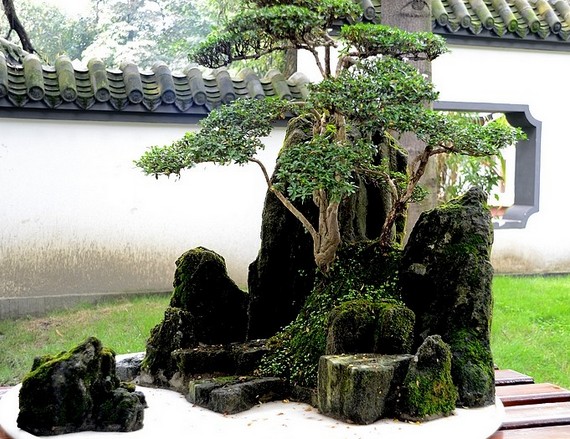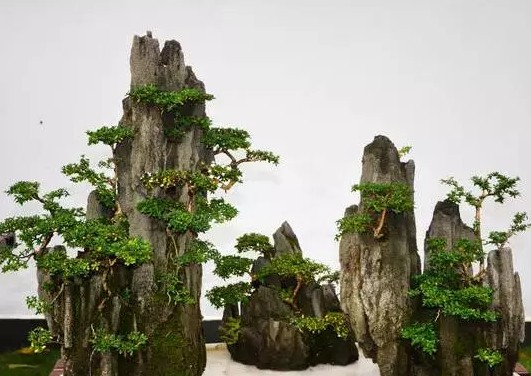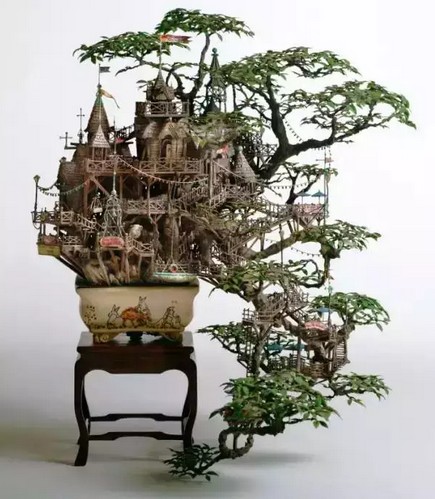Sichuan style bonsai is rooted in Bashan Shushui.
Sichuan bonsai is one of the five major schools of traditional Chinese bonsai, which is deeply rooted in the magnificent and beautiful Bashan Shushui. Bonsai production skills represented by Chengdu area are the foundation and core of Sichuan bonsai production skills.

Sichuan style bonsai has a long history, profound cultural heritage, exquisite craftsmanship and strong local characteristics. As early as the period of Shuhan, Lord Liu Zen built an Le Palace in Chengdu, recommended planting trees in the palace, and reproduced the Qifeng dangerous cliff and ancient wood pine in his memory in the pot. Also made of stone, wood bowls of different length and depth, planted with low trees and equipped with rocks, in the palace is "eight" character decoration. Ministers and merchants have followed suit, and this form of landscaping has spread in Chengdu.
Prince Li Xian of Zhang Huai, who was suspected by Wu Zetian in the Tang Dynasty, was demoted to Chengdu and kept company with bonsai plants all day long to make bonsai for pleasure. In the late Tang Dynasty, when Li Deyu served as an envoy to Xichuan, he built a house on the East Lake in Chengdu, where trees and stones were set off with bonsai plants. Du Fu in the Northern Song Dynasty praised the "West Shu Stone" in his Yunlin Stone Spectrum. Wang Shipeng in the Southern Song Dynasty has a poem "Jiannan Bonsai": "Ergong Xin has a clear ancient appearance and is interesting in Linquan. Cunbi lives far from Jinjiang and lives in the west. The hills and valleys in the mountains are like golden valleys with rough stone canals. I have Qianfeng to hide the wild goose, holding up the sky with a pillar of emptiness. " The author's original preface: "Mr. Jinhua has Qi Shibi, who is far away from Shu Chen Hongzhou."... A Yandang Qunfeng wrong cling, all several cases between things. " The author and the two friends who presented themselves with bonsai are experts in bonsai, praising the bonsai made of strange stones from the distant Jinjiang River.
During the Ming and Qing dynasties, the stump banding processing methods and techniques of Sichuan bonsai have been basically finalized, and the annual Qingyang Palace Flower Temple Fair promoted the exchange of bonsai production skills. In the early years of the Republic of China, Panzha's skills were quite mature and complete, and the bonsai skills of tree stumps were raised to a historical height.
Time: 2019-06-04 Click:
- Prev

Sichuan style bonsai art style
Sichuan bonsai, also known as Jiannan bonsai, is an excellent traditional art of the Han nationality and a treasure of garden art. It is a bonsai art school named after Sichuan Province, and it is also one of the five major schools of bonsai in China. Among them, it is divided into two local styles of western Sichuan and eastern Sichuan, which is famous for its simplicity and preciseness and Qiu qu.
- Next

"Sichuan School" in Chinese Bonsai Art
Bonsai is a work of art with plants and rocks as the basic materials to show the natural landscape in the basin, which is called three-dimensional painting and silent poetry. The bonsai in China originated from the potted plants 7000 years ago, and it appeared in the Han Dynasty. The bonsai began to develop in the Northern and Southern dynasties, and turned to poetic painting in the Tang Dynasty.
Related
- Fuxing push coffee new agricultural production and marketing class: lack of small-scale processing plants
- Jujube rice field leisure farm deep ploughing Yilan for five years to create a space for organic food and play
- Nongyu Farm-A trial of organic papaya for brave women with advanced technology
- Four points for attention in the prevention and control of diseases and insect pests of edible fungi
- How to add nutrient solution to Edible Fungi
- Is there any good way to control edible fungus mites?
- Open Inoculation Technology of Edible Fungi
- Is there any clever way to use fertilizer for edible fungus in winter?
- What agents are used to kill the pathogens of edible fungi in the mushroom shed?
- Rapid drying of Edible Fungi

